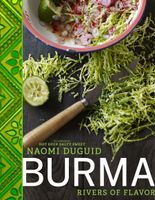Advertisement
Sugar; Sugarcane Sugar; Palm Sugar
By Naomi Duguid
Published 2012
Sugar is made from boiling down the sweet liquid of various plants, including sugarcane, sugar beet, and sugar palm. In Burma very little sugar is used in savory dishes. For making sweets, most people in the cities use palm sugar or commercially produced (from sugarcane) white sugar, but in the countryside a cruder cooked-down form of sugarcane juice, a brown sugar that is sold in blocks, is often used. It has an appealing smoky rich flavor. See “Travels with Sai”. Palm sugar, is made by boiling down the sap of the Palmyra palm (Borassas flabellifer), often called the toddy palm. (The same sap is used to make toddy.) This sugar is called htanyet in Burmese and may also be referred to by its Indian name, jaggery. It’s often served, chopped into small lumps, as an afterdinner sweet in Burmese homes and restaurants; it’s also used for making desserts where a smoky depth of flavor is wanted. Palm sugar comes in many shades and many degrees of smoky flavor, from pale brown and milder-tasting to dark brown and more intensely flavored. Sold in round, square, or cone-shaped blocks, it is now widely available in Asian grocery stores and specialty shops. The flavor is reminiscent of maple sugar, though not as sweet, and so brown sugar, or maple sugar blended with brown sugar, can be substituted. Blocks of palm sugar must be chopped or sliced. This is most easily done with a cleaver. You will notice that in warm humid weather the sugar softens and is much easier to chop. See also toddy; toddy palm.


